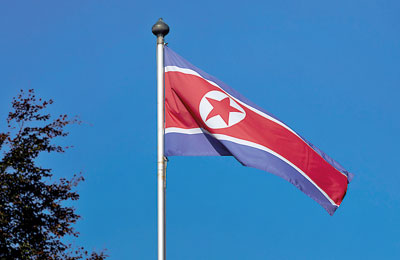Sunday Times 2
Storm clouds over Korea
View(s):By Joschka Fischer
BERLIN – Decades after the end of the Korean War and the partition of Korea, the conflict on the Korean Peninsula remains one of the most dangerous and intractable problems of our time. And today it is more dangerous – and seemingly intractable – than ever.
The North Korean regime is a remnant of the Cold War – a Stalinist dinosaur that has survived to the present day, whereas South Korea has rapidly become an economic and technological power in the region. And China, North Korea’s most important ally and only financial backer, has pursued an increasingly successful modernisation policy.

A North Korean flag flies on a mast at the Permanent Mission of North Korea in Geneva. To date, all diplomatic and technological efforts to prevent North Korea’s nuclear armament have failed. REUTERS/Denis Balibouse/File Photo
These developments have left the North Korean regime isolated and justifiably fearful for its future. So, to ensure that its brutal dictatorship survives, the ruling Workers’ Party of Korea, led by the Kim clan, hit upon the idea of developing nuclear weapons and the systems needed to deliver them.
To date, all diplomatic and technological efforts to prevent North Korea’s nuclear armament have failed. It is only a matter of time until North Korea has nuclear-armed missiles that can reach South Korea and its capital of Seoul, Japan, and even large cities on the West Coast of North America.
The United States, for its part, has installed a missile-defence system in South Korea. And the Trump administration, like administrations before it, views North Korea’s pursuit of intercontinental missiles capable of reaching San Francisco or Los Angeles as a justification for war. If the colour scale used today for terror threat levels were applied to the crisis on the Korean Peninsula, it would show a shift from orange to red. With time for a diplomatic solution – or even containment of the crisis – quickly running out, the situation is coming to a head.
That is because the current drama is playing out in an extremely sensitive strategic location. South Korea and Japan – both important players in the global economy and close US partners – are under immediate threat, whereas China and Russia, North Korea’s two northern neighbours, are global nuclear powers with their own interests in the dispute.
China, in particular, views the Korean Peninsula in terms of strategic security. Chinese leaders have not forgotten that Imperial Japan attacked Northern China (Manchuria) from the Korean Peninsula in the 1930’s, or that it was US troops’ approach toward the Yalu River on China’s border that prompted Chinese intervention in the Korean War, in the early 1950’s.
Since then, China has been North Korea’s quasi-protector, and the US has protected South Korea, not least by keeping a large military deployment in the region even after the Cold War ended. Without that American military presence, war most likely would have returned to the region; or, at a minimum, Japan and South Korea would have developed their own nuclear deterrent.
A military confrontation on the Korean Peninsula could lead to a nightmare scenario in which nuclear weapons are used, or even to a larger clash between nuclear-armed global powers. Either scenario would have serious consequences beyond the immediate geographic vicinity. And yet North Korea’s concerted push to develop nuclear-armed intercontinental ballistic missiles means that a continued wait-and-see policy is no longer a serious option.
So, what will US President Donald Trump do? A series of recent visits to the region by senior American officials suggests that the new administration is treating the situation on the Korean Peninsula as a serious threat. While German Chancellor Angela Merkel was visiting Trump in Washington earlier this month, US Secretary of State Rex Tillerson made his first official trip to East Asia, following Secretary of Defence James Mattis’s trip to the region in February.
When he was in South Korea, Tillerson was anything but reassuring. He spoke of an “immediate threat,” declared an end to former US President Barack Obama’s “policy of strategic patience,” and said that “all options are on the table” – including military action.
Tillerson’s harsh language could be justified if it leads to a negotiated solution among the US, China, and North Korea. But what if that doesn’t happen? Nuclear or conventional war on the Korean Peninsula would carry incalculable regional and global risks. In fact, if one considers those risks carefully, one realises that all options are not on the table: diplomacy, despite all of its difficulties, is the only solution.
A diplomatic solution, however, can be achieved only if the US and China cooperate closely and do not repeat past mistakes. For example, the Trump administration would do well not to pursue an overly aggressive policy toward China in the South China Sea, in light of the burgeoning crisis on the Korean Peninsula.
At the same time, China’s leaders need to ask themselves how much longer they intend to provide unconditional support to the North Korean regime – which is completely dependent on Chinese supplies – rather than putting pressure on it to cease its provocations. To avoid a military conflict, China and the US will need to agree on a joint approach and move toward reviving the Six-Party Talks with North Korea.
It is becoming increasingly clear that, even under a Trump presidency, the US cannot simply shirk its role as a stabilising power on the world stage. And for China to prove that it, too, can be a stabilising power in the twenty-first century, it will have to do its part to resolve the conflict on the Korean Peninsula.
(The writer was Germany’s foreign minister and vice chancellor from 1998 to 2005 and was a leader of the German Green Party for almost 20 years.)
Courtesy : Project Syndicate, 2017. Exclusive to the Sunday Times.www.project-syndicate.org

